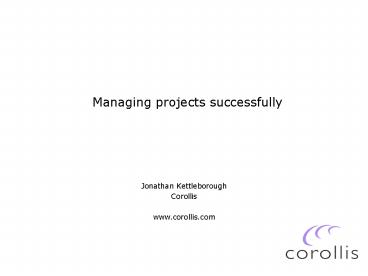Managing projects successfully - PowerPoint PPT Presentation
1 / 36
Title:
Managing projects successfully
Description:
differ little from any other project ... technical experts are not necessarily project experts or client relationship experts. ... – PowerPoint PPT presentation
Number of Views:120
Avg rating:3.0/5.0
Title: Managing projects successfully
1
Managing projects successfully
- Jonathan Kettleborough
- Corollis
- www.corollis.com
2
Agenda
- project lifecycle
- starting out
- issues with e-projects
- the project balancing act
- managing the project
- simple control
- working with clients
- conclusions
3
Todays process
4
- Technology presumes theres just one way to
do things and there never is - Robert M Pursig
- Novelist and philosopher
5
what makes a great project?
6
what makes a nightmare project?
7
what makes the difference?
8
what do you need to know when undertaking
projects?
9
With projects we need to know. . .
- what are we doing
- when are we doing it by
- who are we doing it for
- when are we getting paid and how
- whos doing what
- whats been done, whats got to be done
- what dont we know
- what are the risks
- how do we know weve got it right
- and the list goes on. . . . . . . . .
10
The project lifecycle
11
knowing what you are offering, charging and,
giving away understanding how you add
value and create lasting
relationships
12
what are you offering, charging and,
giving away? how are you adding value and
creating lasting relationships?
13
what do you think that they
actually want?
14
The balancing act
fees
costs
deliverables
promises
15
what do you actually charge your clients for?
16
what do you actually deliver?
17
do you deliver value for money?
18
E-projects
- differ little from any other project
- development tools have lowered the barriers to
market entry e.g. Dreamweaver, FrontPage, Flash,
Access etc. - technical experts are not necessarily project
experts or client relationship experts. . . . . A
good violinist is not a conductor!!! - margins are being squeezed all the time - India
is at least 40 cheaper!!!
19
Issues with e-projects
- many players, many promises, few deliverables
- processes and approaches are critical
- strong management is essential
- e-tools dont always lead to faster development
20
what do your clients demand?
21
more features for less money in less
time with less input
22
are their demands fair?
23
Old thinking
features
fixed
variable
time
resources
24
New thinking
resources
time
fixed
variable
features
25
The transition
resources
time
features
fixed
variable
time
features
resources
26
how do you balance client needs?
27
Project equilibrium
28
which of the key elements is the king?
29
how do you get more out of your projects?
30
the key is processes
31
Project equilibrium
32
Simple control
- project initiation/approach
- risk log
- issues log
- action decision log
- specification
- sign offs
33
Working with clients
- really understand their needs, and then check
again - be strong, be clear
- document all key issues
- compromise dont constrain
- dont promise the world and then fail to deliver
34
Conclusions
- e-projects differ little from other projects
- strong management and project control is
essential - maintain clear and constant client liaison
- honesty in everything you do
35
Any questions?
- Before you go
- this session will have hopefully answered some of
your questions and no doubt raised others. - with this in mind, what else would you like to
know?
36
Contacts
- I can be contacted via the following
- w www.corollis.com
- e jonathan_at_corollis.com
- t 01606 892011
- f 01606 892012
- m 07812 163004































